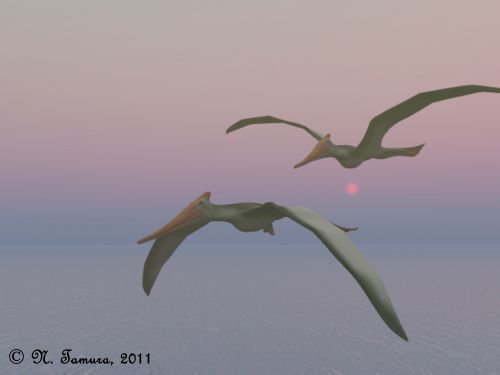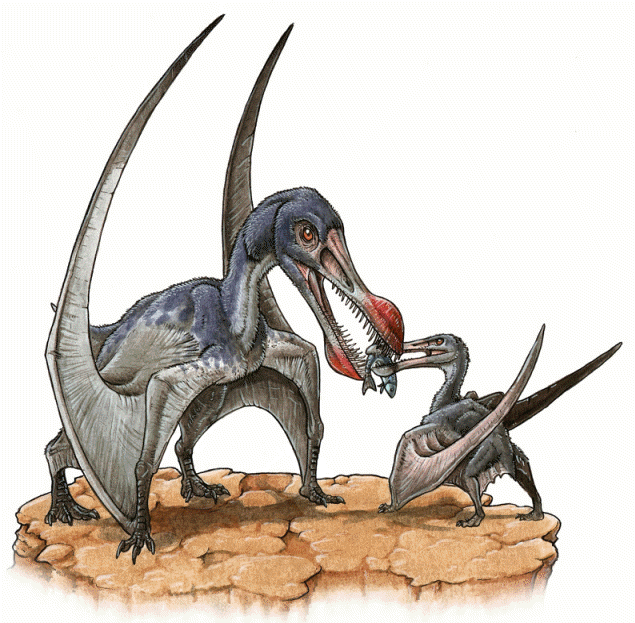[Recent Entries][Archive][Friends][User Info]
October 9th, 2014
| October 9th, 2014 | |
|---|---|
| 12:01 pm [industrialterro] [Link] |
Muzquizopteryx Muzquizopteryx is a genus of pterodactyloid pterosaur (flying reptile) from the Late Cretaceous of what is now Coahuila,Mexico. In the nineties José Martínez Vásquez, a worker at the chalk quarry of El Rosario, uncovered a skeleton of a pterosaur. This he handed to a quarry official, who had it bricked in on the face of an office wall as a decorative piece. After its unique scientific value had been recognised in 2002, the specimen was acquired by the Universidad Nacional Autónoma de México. Subsequently it was studied by a combined team of the University of Karlsruhe and the University of Heidelberg, in this financially supported by the Volkswagen company. The specimen was scientifically reported in 2004. In 2006 the type species Muzquizopteryx coahuilensis was named and described by Eberhard Frey, Marie-Céline Buchy,Wolfgang Stinnesbeck, Arturo González-González and Alfredo di Stefano. The generic name is derived from the Múzquizdistrict and a Greek πτέρυξ, pteryx, "wing". The specific name is derived from the state of Coahuila. Muzquizopteryx is based on holotype UNAM IGM 8621, found in the El Rosario layers, early Coniacian-aged rocks. It consists of a nearly complete, articulated skeleton that includes soft tissue remains, among them long fossilised tendons along both sides of both lower arms. The specimen represents an adult individual. In 2012 a second specimen was reported, MUDE CPC-494, again uncovered by a quarry worker, perhaps at the same site, and sold to a private collector. It was later acquired by the Museo del Desierto Saltillo. It consists of the right upper wing of a subadult individual, with about 81% of the length of the holotype. As its provenance probably consists of slightly older layers from the late Turonian and the remains are limited, it was referred to a Muzquizopteryx sp. Muzquizopteryx was relatively small for a pterodactyloid pterosaur, with a wingspan of around two metres (6.6 ft). It had an elongated head with a convex upper profile, ending at the back of the head in a backward pointing short rounded crest. The jaws were toothless. The arms were very robust with the humerus featuring a large hatchet-shaped deltopectoral crest, indicating a strong wing musculature. The pteroid bone was long and pointed towards the neck, supporting a flight membrane. Muzquizopteryx was by its describers assigned to the Nyctosauridae. It would then be the oldest known member of the group and the smallest known; indeed the smallest adult Late Cretaceous pterosaur discovered until 2006. As Nyctosaurus is sometimes included with the Pteranodontidae, Muzquizopteryx too might be considered a member of that group under some classifications. Tags: Вымершие рептилии, Мел, авеметатарзалии, архозавроморфы, архозавры, диапсиды, монофенестраты, никтозавриды, орнитохейройды, птеродактили, птерозавры |
| Time | Event |
| 12:50 pm [industrialterro] [Link] |
Ornithocheirus Орнитохейр (др.-греч. ὄρνις «птица» и χείρ «рука») — крупный птерозавр раннего мелового периода с размахом крыльев в 2,5 - 5 метров. Орнитохейр обитал в Европе 110 млн. лет назад. Его узкий удлинённый череп плавно переходил в длинный клюв, унизанный острыми зубами. Орнитохейры, по-видимому, населяли побережья морей, берега больших озёр и речные поймы.
Используя восходящие потоки воздуха, наиболее крупные орнитохейры вполне могли пролетать сотни километров, едва взмахивая крыльями. Этому способствовал также относительно небольшой вес, поскольку в костях рептилии находились так называемые «воздушные мешки». С высоты эти птерозавры опускались к поверхности воды за рыбой. Заметив добычу, птерозавр мгновенно погружал в воду клюв, смыкал челюсти и заглатывал рыбу целиком. Высокий килевидный гребень на клюве, по-видимому, помогал орнитохейру удерживать его в вертикальном положении в воде. На суше орнитохейр, как и большинство других птерозавров, двигался медленно и неуклюже, что делало его лёгкой добычей даже для некрупных хищников. Чтобы обезопасить себя от врагов, птерозавры гнездились многочисленными колониями недалеко от воды. А это значит, что прибрежные скалы, утёсы и другие наиболее безопасные и удобные места для гнездования были перенаселены. Окаменевшие кости орнитохейра впервые были найдены в Южной Англии в 1827 году, но свое название этот птерозавр получил только в 1869 году. Размах крыльев у большинства видов орнитохейра не превышал 2,5 м, однако сравнительно недавно в бразильских горах Сантана были найдены останки настоящего орнитохейра-исполина, размах крыльев которого превышал 8 м (ныне этот вид реклассифицирован в отдельный род Tropeognathus). Хотя окаменелости птерозавров известны ученым более 250 лет, одним из первых официального научного названия удостоился орнитохейр. Было описано около 30 видов орнитохейров, но ныне многие из них переклассифицированы в другие роды птерозавров. Ornithocheirus (from Greek "ορνις", meaning bird, and "χειρ", meaning hand) is a pterosaur genus known from fragmentary fossil remains uncovered from sediments in the UK. Several species have been referred to the genus, most of which are now considered as dubious species, or members of different genera, and the genus is now often considered to include only the type species, Ornithocheirus simus. Species have been referred to Ornithocheirus from the mid-Cretaceous period of both Europe and South America, but O. simus is known only from the UK. Because O. simus was originally named based on poorly preserved fossil material, the genus Ornithocheirus has suffered enduring problems of zoological nomenclature. Fossil remains of Ornithocheirus have been recovered mainly from the Cambridge Greensand of England, dating to the beginning of the Albian stage of the late Cretaceous period, about 110 million years ago. Additional fossils from theSantana Formation of Brazil, dating to 112-108 million years ago, are sometimes classified as species of Ornithocheirus, but have also been placed in their own genera, most notably Tropeognathus. The original material of Ornithocheirus simus, recovered from England, indicates a mid-sized species with a wing span of 2.5 m (8.2 ft). Referred specimens attributed to Ornithocheirus simus can reach 5 m (16.5 ft). O. simus bore a distinctive convex "keeled" crest on its snout. Unlike the related Anhanguera and Coloborhynchus, which had an expanded rosette of teeth at the jaw tips, Ornithocheirus species (including O. simus) had straight jaws that narrowed toward the tip. Also unlike related pterosaurs, the teeth of Ornithocheiruswere mostly vertical, rather than set at an outward-pointing angle. They also had fewer teeth than related species. The type specimen of Ornithocheirus simus is represented only by a broken piece of the upper jaw tip. While it does preserve several characteristic features of Ornithocheirus, it is nearly identical to comparable bones in Tropeognathus mesembrinus, making clear distinction between these two species impossible. ( Read More )</span> Репродукции (1, 2, 3, 4, 5, 6): Tags: Вымершие рептилии, Мел, авеметатарзалии, архозавроморфы, архозавры, диапсиды, монофенестраты, орнитохейриды, орнитохейройды, птеранодонтойды, птеродактили, птерозавры |
| Previous Day | 2014/10/09 [Archive] |
Next Day |












